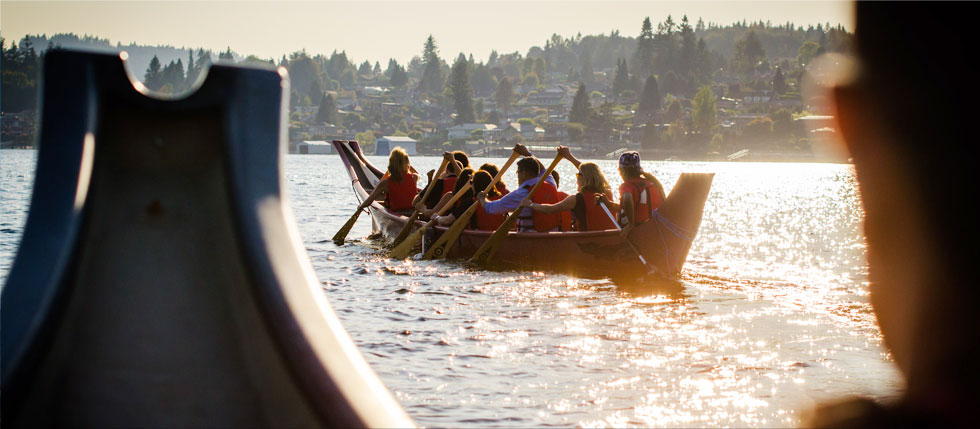This story is brought to you by the Aboriginal Tourism Association of BC. Click the logo above to stay connected to the Aboriginal community.

Takaya Tours offers a glimpse back in time.
Photo courtesy ATBC
KATE MACLENNAN
Down at the dock, two traditional, eight-metre First Nation canoes float, dead still, in the briny, grey waters of Indian Arm. They are waiting to take us out into the Burrard Inlet and back through time — if the fog abates.
Guy, one of the guides tag-teaming our tour with two others, Wes and Cease, reluctantly makes the call: it’s too foggy to go out; we won’t be able to see potential hazards or other boaters. Heck, we can barely see 75 metres in front of us.
Our group, a class of MBAs from New Zealand plus one curious North Vancouver local — me — is collectively disappointed. We’ve arrived at Cates Park near Deep Cove for a Takaya Tour to experience the historic ways of the Tsleil-Waututh First Nation who have occupied the Indian River watershed for centuries.
What we don’t realize yet is that the fog has created a greater opportunity for us — a chance to explore the ancestral grounds of Whey-ah-Wichen (Faces the Wind) Park in a more comprehensive way than we expected.
Peeking behind a curtain
Our guide trio officially kicks off our tour with a song of welcome that sounds as old as their rain-repelling jackets are modern. They sing together in a language none of us can understand as Guy beats a hand-held drum. As their voices float up into the cedars that drip water down upon us, I can’t ignore the feeling that I’m peeking behind a curtain and getting a glimpse of a society I would never typically be privy to.
Wes validates my thoughts when he asks that we not take video or record the song, explaining that it’s meant to only be passed along orally. (The pragmatic journalist in me hates to think of the details potentially lost from generation to generation, but the romantic in me loves the concept.)
After, we’re taught that to express appreciation as the Tsleil-Waututh do — holding our hands up, our elbows making a right angle, palms towards our faces — we head into the wet forest.
Magic of the forest
The flu season has its snotty grip on several of us, so Cese leads us straight to a tree sprouting a rug of bright green ferns from its trunk. It’s licorice fern, she explains, demonstrating that by carefully wiggling the moss aside you expose the plant’s root.
Licorice fern in the forest.
Photo courtesy Kate MacLennan
Chewing on just a small piece of the root helps ease sore throat, cough and flu, she says, passing us all a chunk. I dig right in. It tastes at first like a fresh pea, and then the licorice flavour starts to come out. I don’t know why I’m surprised that my cough eases off as I continue to chew it.
We follow the guides through the trees, learning about the flora that helped to sustain the indigenous people hundreds of years ago —salmonberries and huckleberries, elasticky mosses that can be boiled into tea, skunk cabbage leaves for preparing and wrapping food and the revered western red cedar tree, the “tree of life” from which the Tsleil-Waututh people could get nourishment and use to make long houses, totem poles, canoes, and much more.
Guy and Cease get ready for the canoe tour at Deep Cove.
Photo courtesy Kate MacLennan
Paddling into the past
Our ground tour of the former village of the Tsleil-Waututh Nation is over far too soon, and we’re ushered to picnic tables to nosh on traditionally prepared salmon — a keystone species for the area’s First Nations — and bannock, a traditional bread. As we eat, the opposite coastline of the inlet begins to appear as the blanket of fog finally heeds our request and lifts.
A traditional dugout cedar canoe can weigh more than 450 kilograms, but our fibreglass replicas weigh only 180 to 200 kilograms. And, after a brief lesson in how to use the wooden, diamond-bladed ocean-going paddles, we discover our craft will cut cleanly, quickly and with surprising stability through the water if our paddles are in sync.
From her perch at the front of our canoe, Cease beats softly on the drum, sings us a mother’s song, and our group sinks into a sort of daze. I look back from the water on what is now known as Cates Park and contemplate that it was once home to some 350 people. I wonder if they would recognize it now. I know I’ll never look at it the same way again.
Source:
http://www.festivalseekers.com/vancouvercoastalfestival/takayatours
